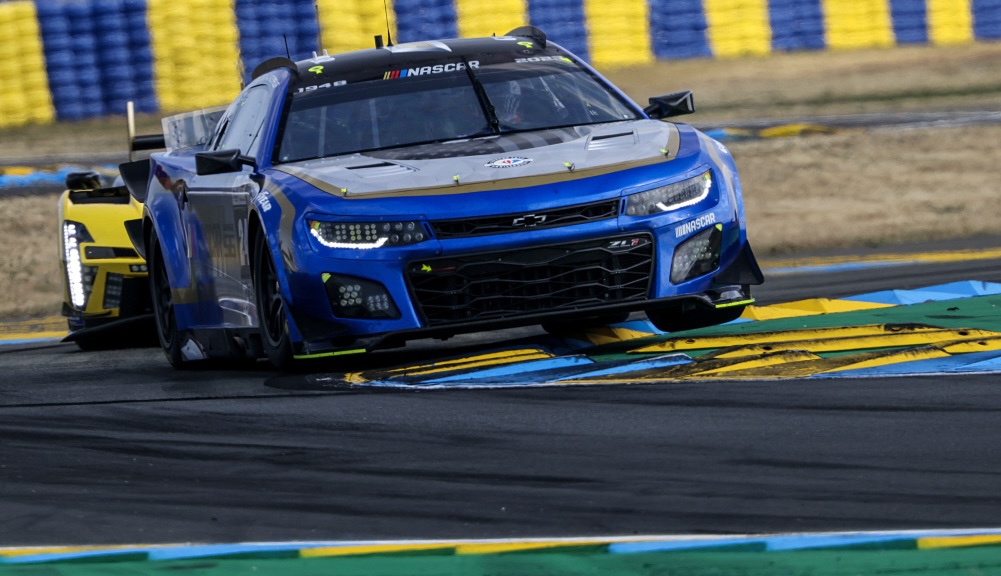
When you look back on the 2023 FIA World Endurance Championship season, what will you remember most? Toyota’s title? Ferrari’s historic centenary Le Mans triumph? The Iron Dames claiming the final GTE race win? Or maybe, you’ll look back most fondly on the thundering, heavily modified NASCAR Cup Series Chevrolet Camaro ZL1 that took part in the Le Mans 24 Hours?
NASCAR’s Garage 56 project was undoubtedly one of the sports car racing stories of the year. And upon reflection, it feels even more remarkable and impressive now than it did at the time. Memories of the noise alone still keeps many Le Mans-goers who were trackside in June awake at night!
It was an effort that captured an astonishing amount of attention and won over just about every skeptic, despite the 2023 24 Hours being the event’s centenary running and the top-class battle for the overall win proving to be the most competitive and captivating it had been in years.
For the Hendrick Motorsports crew, which is so deeply embedded in the near-weekly fight for supremacy in the Cup Series, its journey to Europe to run the 5.8-liter V8-powered Chevy was like no other. And despite the buzz and excitement that surrounded the team from the moment it touched down in France and the inconvenience of the race falling mid-way through the racing calendar, the team remained focused and professional and delivered the goods in every respect.
The Camaro, which ran outside of the four main categories in a class of its own, made the finish after 285 laps and did so in fine style. Its trio of star drivers — Jenson Button, Jimmie Johnson and Mike Rockenfeller — ran the car at a head-turning pace and avoided creating any on-track dramas for the competitors in the other classes. The team did everything it set out to achieve and a whole lot more.
Before, during and long after the 24 Hours, the media attention proved constant. IMSA President John Doonan (who managed the team and program) admitted that he was almost overwhelmed by it.
“My phone keeps buzzing,” he told RACER at Brands Hatch the weekend after Le Mans, where the Garage 56 Camaro was displayed at the British circuit’s American Speedfest. “Every time I look down someone has written about it or posted pictures and videos. It really is amazing.”
The reach of the program was phenomenal, with 12,875 pieces of coverage counted in print and online and 33.4 million social media impressions on its official channels during the year. And it remains a talking point in motorsport circles around the world, months on from its one and only appearance.
However, before the Camaro and its legacy at Le Mans become a distant memory and focus shifts to the 2024 racing season, there’s one more tale to tell, and that is the key work behind the scenes at the FIA to ensure that the car was eligible to compete in the first place. Without determination and willingness to compromise, one of the most quirky and popular cars in the race’s history may have never turned a lap there in race week.
With NASCAR’s safety regulations significantly different to the FIA’s regulations in place for the 24 Hours, there had to be some give and take. From the moment the program was green-lit and revealed in 2022, there was an open dialogue between all key parties to ensure that by the time Le Mans week rolled around the race organizers, competitors, marshals and drivers would be ready to host the Camaro for its first endurance race.
Xavier Mestelan, the FIA’s chief technical and safety officer, was a key player in the FIA’s relationship with NASCAR, IMSA and Hendrick Motorsports, and recalls it being an exciting project to work on.
“My first thought was that it was a bit strange,” he reflects. “Garage 56 is usually something for new technology. So it was funny, but in parallel it was very exciting for the FIA. It was completely new, and the car is extreme in terms of weight, power and design.”
The FIA’s role in the Garage 56 project was to assess the car’s safety and give feedback throughout its development to the parties working on the car.
It was a two-way relationship, with so much preparation, including the FIA paying Hendrick Motorsports a visit at its shop before the IMSA-WEC Sebring doubleheader for a meeting “to discuss the project with engineers and share concerns” in the months leading up to Le Mans.
“It was a very good collaboration — we wanted to take the best practice from both sides of the Atlantic,” Mestelan explains. “For all the main safety requirements for the car, we clearly asked NASCAR to make all the adaptations needed. But for some other matters like the seat, we concluded that their technical choice was relevant for the car. We tried to take the best elements from each set of regulations.
“For example, the helmets and overalls NASCAR use are the same standard (as the FIA). For the crash structure, though, when you develop a standard you have to take into consideration the whole ecosystem, the types of barriers and each course type. What NASCAR do is something suitable to their tracks, so on our side we have the same for our tracks and our standards.”
The car’s weight turned out to be the most crucial factor in ensuring the car was deemed suitable to race at Le Mans. A standard Cup Series Camaro ZL1 weighs in at 3,200 lbs (1,451kg), which was thought to be too heavy. But the FIA worked with NASCAR to come up with solutions that would reduce the car’s weight to a similar figure to the GTE cars (eventually 496 lbs/225 kg lighter), which the Camaro’s bespoke safety regulations were based on.